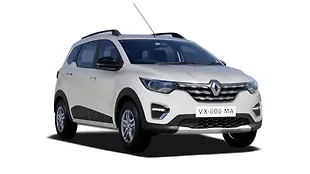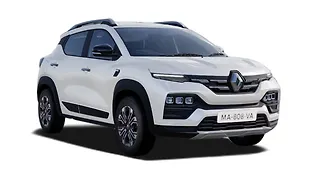What is it?

For potential buyers who love the way the Kwid looks but were put off by the underwhelming 799cc engine, Renault has just introduced the much awaited 1.0litre version of the car. The significant bump in power and torque figures promises to give this Renault hatch some extra oomph especially for highway use. So has the heart transplant made the Kwid significantly better? We flew to Chennai to find answers.

On the outside the Kwid remains more or less the same. So you get the familiar mini crossover stance which makes it look distinctive and imposing. The large upright honeycomb grille, high bonnet and chunky headlamps further add to its SUV like styling and the flared wheel arches with plastic cladding gives it a mini Duster look. So how will your colleagues know you are driving a faster Kwid? The most prominent changes are the chequered decals pasted across the doors, the new chunkier silver mirrors look upmarket (but you still don’t get internal adjustment) and our test car didn’t have roof rails which made it look shorter and sleeker. Although the decals look a bit loud and overdone, they do a good job of distinguishing the 1.0 from the regular Kwid.
How is it on the inside?

On the inside there are absolutely no changes so you get the same minimalistic yet smartly styled dashboard. As before the seven-inch touchscreen infotainment system dominates the proceedings. This system is not only unique at this price point, but it also gets features like a navigation system that is unheard of in cars that sit two segments higher. We also liked the ergonomic AC controls which are nice and chunky and the Aux/USB ports for the music system are conveniently placed. The snazzy digital instruments further add to the modern look and the large speedo display is easy to read on the move. But in terms of the quality the Kwid’s cabin looks budget with hard but durable plastics all round and panel gaps are inconsistent too. This is where cars like the Hyundai Eon have a distinct advantage over the Kwid. The Renault’s cabin though is quite practical and front passengers enjoy loads of storage spaces. But at the rear there are absolutely no storage spaces except for the rear parcel tray which is disappointing.

Despite its diminutive size the small Renault is surprisingly spacious. Visibility out of the high mounted front seats is really good and the high bonnet gives you a commanding feel. The front seats are surprisingly good despite limited bolstering. But they are perched too high up as headroom is limited especially for six foot plus drivers. The steering is placed a bit too low too as a result driving ergonomics are not the most comfortable. The backseat is a real highlight and the generous knee room, long squab and well-angled backrest makes it a nice place to be in. On the downside the cabin is a touch too narrow and sitting three at the back is an uncomfortable experience. The boot at 300 litres is humongous and the loading bay is well-shaped too.

The Kwid 1.0 litre will be available in just the top RxT and RxT option variants. As a result it comes loaded with lot of features. You get front power windows, air-con, power steering, and a touchscreen infotainment system that houses features like Navigation, Aux-in/USB ports and a radio. Where convenience equipment impresses, the safety features leaves us a bit disappointed. You just get a single driver side airbag and that’s it. We would have liked Renault to offer ABS at least as an option and the rear passenger seatbelts aren’t even inertia reel type. Yes its rivals too lag in this respect but this was a good opportunity for Renault to make a head start in this critical area.
How does it drive?

Now onto the biggest change - the engine. The Kwid 1.0-litre is powered by a 999cc motor which is good for 67bhp and 91Nm. That’s a significant 14bhp and 19Nm more than the 800cc version. Just the twist of the key is enough to establish the fact that the new motor is much more refined than the standard car. Compared to the 800cc motor, idle on this version is a lot smoother, there are less vibrations on the gear lever and it feels quieter too. The new engine makes an even bigger impression once you ease off the clutch and get moving. There’s less of that low rpm jerkiness of the 0.8, rather, you’d find power delivery to be crisp and pulling power to be quite good too. It makes the Kwid feel light and agile to drive as the larger engines throttle responses are drastically better and it pulls well from most engine speeds. This flexible nature also means you don’t have to shift as often as you have to on the 0.8 litre car and this makes your life much easier in bumper to bumper traffic. The taller gearing and good spread of torque also means, the Kwid 1.0 litre feels at home on the highway now. Overtaking is much easier and it needs only a shift or two to accelerate with gusto. Yes, on first impression it doesn’t feel as peppy or refined as say the Alto K10, but it’s more than upto the job of comfortably propelling the Kwid to speed. A light clutch and reasonably smooth-shifting five-speed gearbox round this off as a car that is a huge step over the regular one.

Thanks to the great visibility, compact size, small turning circle and light controls, the Kwid is easy to punt around in traffic. This, combined with the absorbent low-speed ride, makes the Kwid a very potent urban tool. The larger engine has added 31kg to the kerb weight, as a result the front-end feels more planted at higher speeds and straight-line stability is quite good. However, encounter a rough patch at higher speeds and the Kwid starts to get skittish and this nervous feeling forces you to exercise a bit more caution. The Kwid also tends to get affected by strong crosswinds too and the light weight and high proportions are to blame here. When it comes to handling, when driven at moderate speeds the Kwid shows good composure. But enthusiasts will come away disappointed as soon you push the cars dynamic envelope. The light steering is very vague and there is considerable body roll (Kwid doesn’t get antiroll bars) which is quite disconcerting. The steering also doesn’t self centre so you have to make constant corrections to help the Kwid go in the intended direction. We also feel Renault should have upgraded the brakes on the Kwid 1.0. As we discovered considerable fade and even the brake felt a bit grabby and inconsistent.

Should I buy one?

We expect the Kwid 1.0 litre to cost around Rs 40-45,000 more than the standard variant. So does the more powerful engine justify the higher price tag? If initial impressions are anything to go by then absolutely yes. The new motor feels much more potent and it is much easier to drive. The fact that the Kwid now feels at home on the highway, makes it more versatile and suitable for a person who does little bit of highway running too. So the heart transplant has definitely made the Kwid a complete package.
Where does it fit in?

The Kwid 1.0’s main rivals will be the Maruti Alto K10 and the Hyundai Eon 1.0. We expect the Kwid to be priced at par with the Maruti and significantly undercut the Hyundai.
Pictures by: Sanchit Arora
Click here for Kwid 1.0 vs Eon 1.0 vs Alto K10 spec comparison

![Renault Kwid [2015-2019] Exterior Renault Kwid [2015-2019] Exterior](https://imgd.aeplcdn.com/642x361/cw/ec/24560/Renault-Kwid-10litre-Exterior-78720.jpg?v=201711021421&wm=1&q=80)
![Renault Kwid [2015-2019] Dashboard Renault Kwid [2015-2019] Dashboard](https://imgd.aeplcdn.com/642x361/cw/ec/24560/Renault-Kwid-10litre-Dashboard-78733.jpg?v=201711021421&wm=1&q=80)
![Renault Kwid [2015-2019] Exterior Renault Kwid [2015-2019] Exterior](https://imgd.aeplcdn.com/642x361/cw/ec/24560/Renault-Kwid-10litre-Exterior-78731.jpg?v=201711021421&wm=1&q=80)
![Renault Kwid [2015-2019] Gear-Lever Renault Kwid [2015-2019] Gear-Lever](https://imgd.aeplcdn.com/642x361/cw/ec/24560/Renault-Kwid-10litre-GearLever-78736.jpg?v=201711021421&wm=1&q=80)
![Renault Kwid [2015-2019] Engine Bay Renault Kwid [2015-2019] Engine Bay](https://imgd.aeplcdn.com/642x361/cw/ec/24560/Renault-Kwid-10litre-Engine-Bay-78742.jpg?v=201711021421&wm=1&q=80)
![Renault Kwid [2015-2019] Rear Seat Space Renault Kwid [2015-2019] Rear Seat Space](https://imgd.aeplcdn.com/642x361/cw/ec/24560/Renault-Kwid-10litre-Rear-Seat-Space-78739.jpg?v=201711021421&wm=1&q=80)
![Renault Kwid [2015-2019] Instrument Panel Renault Kwid [2015-2019] Instrument Panel](https://imgd.aeplcdn.com/642x361/cw/ec/24560/Renault-Kwid-10litre-Instrument-Panel-78737.jpg?v=201711021421&wm=1&q=80)
![Renault Kwid [2015-2019] Interior Renault Kwid [2015-2019] Interior](https://imgd.aeplcdn.com/642x361/cw/ec/24560/Renault-Kwid-10litre-Interior-78738.jpg?v=201711021421&wm=1&q=80)
![Renault Kwid [2015-2019] Image Renault Kwid [2015-2019] Image](https://imgd.aeplcdn.com/272x153/cw/ec/18713/Renault-Kwid-Exterior-132531.jpg?wm=0&q=80)

























